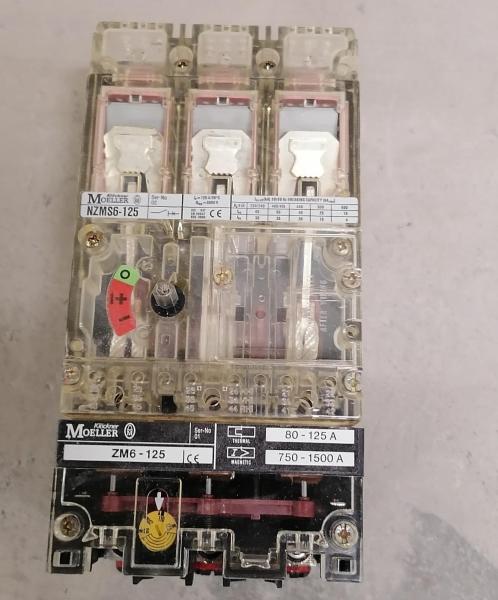Customer voice

125A C/B 3P 600V
References:
KLOCKNER MOELLER : NZMS6-125/ZM6-125 + H6U
SKU : kh016N637_BBE
Condition:
Like new
158.62€ Tax Excl.
Sold by kheoos
158.62€ Tax Excl.
Like new
Availability : In-stock
1 article remaining in stock
To get a quote, add your products to the basket and generate your quote.
We're shipping in less than 48h

All parts are in stock
With our partners

Quote
To get a quote, in your basket, click on « get a quote » and add the reference(s)

Online payment or after quote
If you can not pay by card or bank transfer

Receive bills
For all your orders

Shipping worldwide

Product warranty

90 days return
If parts have problems
Specifications
Product origin
Stock origin
European construction industrialist
Storage condition
Excellent - Warehouse-ventilated area, away from dust (storage cabinets)
Warranty
3 months
Our other offers
| Condition: | Vendor | Price |
|---|---|---|
| Like new | kheoos Voir les produits du vendeur | 158.62€ Tax Excl. (par unité) |
Our conditions
| Condition: | Description |
|---|---|
| New | New - Item never used, unopened, sold in the original packaging |
| Like New | Like New - Item in excellent condition, without signs of wear, in its original packaging or refurbished, small defects possible that do not affect the operation |
| Refurbished | Refurbished - Item repaired, inspected and cleaned by the seller or by a third party not necessarily approved by the manufacturer and in excellent working condition |
| Used | Used - Item having been used, showing some superficial signs of wear, fully operational and working properly |
About the category
The motor protection circuit breaker is an essential component in the field of industrial electricity. It protects electric motors against overloads, short circuits and other anomalies that can cause significant damage to equipment and endanger worker safety.
The motor protection device, commonly called a motor protection circuit breaker, is primarily used to protect an electric motor. Motors are subject to various constraints during their operation, such as overloads, imbalances between phases or insulation faults. In the event of an anomaly, if no corrective action is taken quickly, this could result in a malfunction of the engine or even its destruction. This is where the motor protection circuit breaker comes into play.
In fact, this type of circuit breaker detects these problems and triggers a power cut when necessary. This makes it possible to protect not only the motor, but also the cables supplying it, the connected machines as well as the personnel working nearby. Due to its crucial role, it is essential to understand how a motor protection circuit breaker works.
Motor protection circuit breakers generally operate on two principles: thermal sensing and magnetic sensing. These two complementary mechanisms help to identify different types of anomalies in the electrical circuit supplying the engine.
The thermal detection principle is based on the use of a bimetallic element. The latter is composed of two metals with different expansion coefficients, which are glued or welded together to form a bimetallic blade. When the temperature increases due to overload, the bimetallic element bends due to the difference in expansion between the two metals. This deformation then causes the power supply to be cut off.
This method mainly detects long-lasting overloads, that is to say those which persist for several minutes or even hours, as well as insulation faults. The tripping value of the motor protection circuit breaker can be adjusted according to the characteristics and needs of the protected motor.
Magnetic detection, for its part, makes it possible to detect short circuits and brief but intense overcurrents. The principle is based on the magnetic effect of current flow in a solenoid. In the event of an overcurrent, the magnetic field generated is intense enough to move a ferromagnetic core inside the solenoid, causing the electrical circuit to break.
This method is particularly effective in quickly identifying and stopping short circuits, thus avoiding serious damage to the motor and reducing the risk of fire or accident.
In order to ensure optimal protection of the motor, it is essential to properly configure the functions and tripping thresholds of the circuit breaker according to the characteristics of the motor and its installation.
The first fundamental adjustment concerns the nominal current of the protected motor. The latter must be calibrated taking into account the maximum value of the current that the motor can withstand without suffering damage or mechanical stress. This parameter varies depending on the manufacturer's specifications and the power of the engine concerned.
Once this value is adjusted, the circuit breaker will open the circuit if current above this threshold flows for an extended period of time. This ensures both protection of the motor against overloads, and its optimal performance during normal operation.
In addition to the rated current, setting the trip delays is also crucial to ensure adequate protection. These delays generally vary between a few seconds and several minutes, depending on the types of anomalies detected.
It is important to adjust these delays taking into account in particular the capacity of the motor to withstand temporary overloads without damage (for example during start-up or during a specific work cycle). Once these parameters have been properly calibrated, the motor protection circuit breaker will be able to effectively protect the machine throughout its operation.
The motor protection circuit breaker is a key component in the management and safety of industrial electrical systems. Adopting a rigorous approach in terms of choice, configuration, monitoring and maintenance of this device helps to ensure optimal and sustainable operation of the installations while preventing the risks inherent to electrical equipment.
Trusting kheeos for the acquisition of your protection circuit breakers guarantees you high-tech products while committing to a more ecological industrial future.